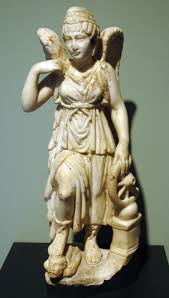We should remember Nemesis among the deities who had dealings with the fate of human life, which represented the outrage over every moral disorder, and everything that seems to upset the normal balance of society like too much happiness of some people or the overbearing arrogance of others; in such cases the goddess Nemesis would have no peace unless the balance of things had been restored.
Homer didn’t know this goddess, and Hesiod himself was not able to propose a more precise definition of her, because the idea of Nemesis as retributive justice became well defined only in late Greek literature. Nemesis was venerated in the Attic town Rhamnus (so she was called Rhamnusia), where the goddess was believed to be daughter of Nox and Oceanus. Nemesis, depicted as a winged demon, was worshipped also in Smyrna or Izmir.
Francis Bacon, the great philosopher, said that the myth of Nemesis should be so explained: “They who enjoy long flow of happiness and power doubtless become subject to her at and are brought to yield.”
During the 2nd century AD the Cretan poet Mesomedes (see below, Sir Edwin Arnold) composed a hymn in honor of Nemesis:
“Daughter of Justice; winged Nemesis;/Thou of the awful eyes/ Whose silent sentence judgeth mortal life/ Thou with thy curb of steel/ Which proudest jaws must feel/ Stayest the snort and champ of human strife/ And, hating miserable pride of men,/ Dost tame fierce hearts and turn them meek agen [=again].”
This deity was also upheld by the Romans, and as attested by Pliny the Elder, a statue honoring her would be erected on the Capitol at Rome. But the Romans, who were afraid of bad luck, did not give her any Latin name, so they named her Nemesis, like the Greeks:
“There was a statue of Nemesis in the capital at Rome; though we learn from Pliny that this goddess had no name in Latin (Hist. Nat. XXVIII, 5. XI, 103.5).” ( Arts and Sciences).There are many poems about Nemesis that can be read in the Palatine Anthology. Catullus wrote in one of his poems (50. 16-21):
“[Nemesis] est vemens dea; laedere hanc caveto” (She [Nemesis] is a very potent goddess: take care not to offend her).
In any cases, it is best for us to be cunning, and free both from excessive happiness and the hunger for power. The ancient Greeks smelled danger, and they tried to win the favor of the terrible goddess Nemesis with a festival in her honor called Nemesia. And so the artful Greeks satisfied the terrible goddess Nemesis.
Is there no one here called foolish?
No one there!
This is a wise decision, and I’m very happy for you.
Sources:
Sir Edwin Arnold, “Mesomedes”, in The Poets of Greece, London, 1869, p. 130. “Of the poet nothing more is known than that he was a freedman of Hadrian, and therefore of a very late age in literature. Two of his epigrams only are extant, with an invocation to Nemesis, the Goddess of Divine Equity and Final Restitution.”
Arts and Sciences or Fourth Division of The English Cyclopedia, Conducted by C. Knight, London, 1867, Vol. V, p. 919
The Philosophical Works of Francis Bacon, edited by Peter Show, London, 1733, p. 595.
About agen–again: Sax. Agen; again; in return. See again. A Dictionary of the English Language, by Samuel Johnson, London, 1818, AGE.
